 |
||
|
||
| ||
 Contents
Several months ago NVIDIA released the updated solutions built on the GeForce4 Ti 4200 and GeForce4 MX 440 with the AGP8x support. They can hardly be called new products as they differ from the previous versions only in this support. Our tests revealed that this mode is useless for the 128MB cards (and all GeForce4 Ti 4200 models ship with exactly this RAM size onboard), and hardly useful for the 64MB cards; moreover, the AGP8x support is too poor on the VIA KT400 based boards; although it's much better on the SIS648, such boards are not widely popular. Below is the list of reviews covering also the MX 440-8x (the short name used by us for the GeForce4 MX 440 with AGP8x). Theoretical materials and reviews of video cards which concern functional
properties of the
Today we are to examine three new cards based on the MX440-8x. But it's not just another fashion show and a bunch of diagrams for the 3Digest. We will look again at the capabilities of the today's leader of the mainstream market and even of the low-end one. There are a lot of spears broken in the fight between the MX440 and ATI RADEON 9000/Pro. The new RADEON was on the brink of the victory when NVIDIA hit it from behind with its Mx440-8x. It might seem that the blow is too weak because of the lifeless AGP8x, but the marketers recommended that NVIDIA lift the card's frequencies, i.e. equip the card with faster memory and raise the chip's speed up to 275 MHz (this is the frequency the RADEON 9000 Pro works at :-). The new MX440 turned to be faster than the old one, but not at the expense of the AGP8x, but due to the higher clock speeds. At the same time, we found out that all new super memory optimization technologies which were so much touted, on the GeForce4 MX as well, weren't of much help. Actually, they lifted up only the memory frequency from 200 to 256 MHz (400 to 512 DDR), and the speed went up markedly. The GeForce4 MX is much limited by the memory bandwidth, though not so badly as the GeForce2 MX. And it depends on the memory's clock speed. This is what NVIDIA used in its trick. But what about the prices? This is still a new product, while the RADEON 9000 Pro has been selling several months already. Fortunately, the MX440-8x has an acceptable one. Moreover, some manufacturers jacked up the speed of such cards and equipped them with faster memory, though the 3.6ns memory recommended by NVIDIA provided a solid frequency reserve (the rated frequency of such memory is 275 (550) MHz and it is clocked at 256 (512) MHz by default). Will the new cards be competitive against the Ti 4200? Very unlikely, because the MX440 has less rendering pipelines, lower frequencies, lacks a normal multilevel anisotropy support, EMBM, and pixel shaders; vertex shaders are on the shoulders of the CPU. Well, the GeForce4 MX has only the MSAA from the Ti line, which is noticeably faster than the old SSAA, as well as some memory optimization technologies, but they are too scarce here. The MX440-8x remains a competitor against the RADEON 9000 Pro: it might lose to the latter in functions and DirectX 8.1 support, but can work more efficiently. Well, today we will check it. Besides, we will pump the cards through the tough modes with AA 2x and anisotropy 2x (unfortunately, the MX440-8x can't work at higher levels). So, one of three cards in question is from ASUSTeK. The other two are copies of the reference design. CardsAll the cards have |
| ASUS V9180 VideoSuite | |
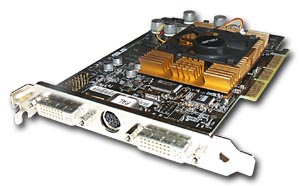 |
 |
| ABIT Siluro GF4 MX-8X | |
 |
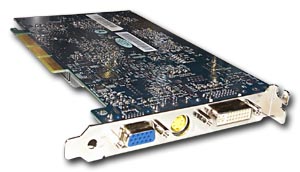 |
| Inno3D Tornado GeForce4 MX440-8X | |
 |
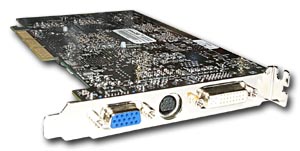 |
| ASUS V9180 VideoSuite | |
| This card comes with Samsung memory modules of 3.3ns access time. The card works at 304/285 (570) MHz. The chip's speed is increased by 29 MHz relative to the one recommended by NVIDIA, and the memory runs at the speed faster by almost 30 (60) MHz. |  |
| ABIT Siluro GF4 MX-8X | |
| This card comes with Samsung memory modules of 3.6ns access time. The card works at the rated frequency of 275/256 (513) MHz. |  |
| Inno3D Tornado GeForce4 MX440-8X | |
| This card comes with Samsung memory modules of 3.6ns access time. The card works at 275/256 (513) MHz. |  |
| Comparison with the reference design, front view | |
| ASUS V9180 VideoSuite | Reference card NVIDIA GeForce4 MX 440 with AGP8x |
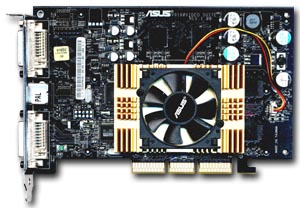 |
 |
| ABIT Siluro GF4 MX-8X | |
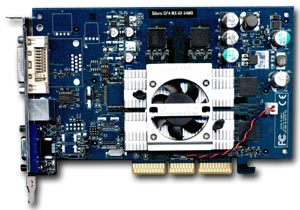 |
|
| Inno3D Tornado GeForce4 MX440-8X | |
 |
|
| Comparison with the reference design, back view | |
| ASUS V9180 VideoSuite | Reference card NVIDIA GeForce4 MX 440 with AGP8x |
 |
 |
| ABIT Siluro GF4 MX-8X | |
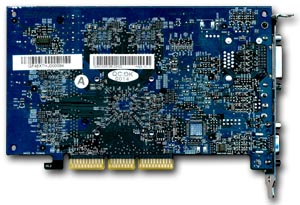 |
|
| Inno3D Tornado GeForce4 MX440-8X | |
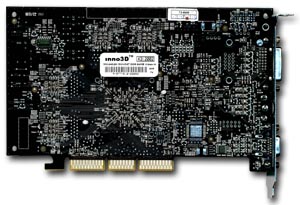 |
|
The models of ABIT and InnoVision are in full conformity with the NVIDIA's recommendations, they follow the reference design in every way. The ASUSTeK's card has a different design and supports the status hardware monitoring, the temperature mode is controlled by the Winbond chip: 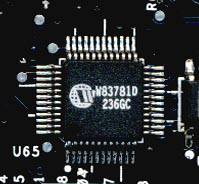 Secondly, this card is equipped with the faster, 3.3ns, memory which allowed the developers to lift the memory frequency up to 285 (570) MHz. The chip's speed was set to 304 MHz (neither 300 nor 305 :). The MX440 can easily reach such level because the MX460 working at 300 MHz by default has the same chip as that of the MX440. But I think ASUSTeK tests all MX440-8x chips before they are mounted onto the cards and clocked at 304 MHz. Thirdly, the card has two DVI connectors and it comes with two respective d-Sub adapters. It makes possible to connect the card to two digital monitors, contrary to other similar models. So, today this is the fastest MX440-8x based solution with higher default frequencies. However, there is also Gainward's card of the Golden Sample series which in the Turbo mode runs at 300/300 (600) MHz; but this mode can be enabled only with the special ExperTool utility, while the ASUSTeK's can work at the increased frequencies with any drivers and isn't bound to the proprietary software. The other two cards don't have any interesting differences from the reference sample. Here are the coolers:
|
Under the coolers we have the GeForce4 MX440-8x processor: 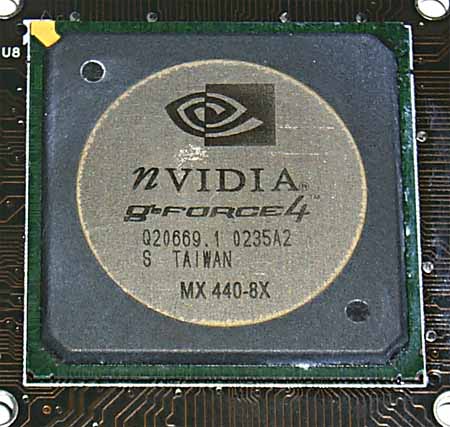 All the cards except ABIT have the Philips 7114 codec providing VIVO: 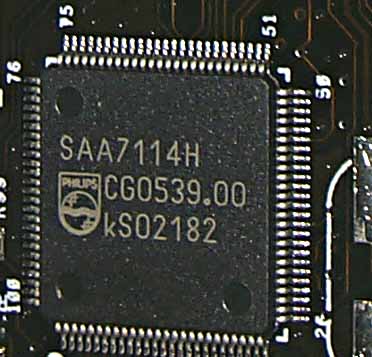 The ABIT's card doesn't have an external codec that is why TV-out is provided by the GeForce4 MX 440-8x. I must say that when the TV is connected to the card and the monitor is attached with the d-Sub, an image appears only on the TV screen. Only when we made some changes in the drivers and rebooted the Windows, the image was successfully returned to the monitor. I think it's on account of the imperfect internal TV-out chip. That is probably why external TV codecs are used more often. Now have a look at the accessory packs.
|
All the cards ship in the retail package.
That's all we had to say about peculiarities of the card.
| ASUS V9180 VideoSuite | 304/570 -> 370/690 MHz |
| ABIT Siluro GF4 MX-8X | 275/512 -> 332/630 MHz |
| Inno3D Tornado GeForce4 MX440-8X | 275/513 -> 330/638 MHz |
As expected: the faster the memory, the higher the overclocking potential. And it's now clear that ASUSTeK uses selected chips for such cards (the potential is markedly higher). Note:
 Test system and driversTestbed:
The test system was coupled with In the tests we used NVIDIA's drivers of v40.72. VSync was off, S3TC was off. For comparison we used the following cards:
The ABIT and InnoVision cards are marked further as NVIDIA GeForce4 MX440 with AGP8x because they demonstrate the same performance. Test resultsBefore we start examining 2D quality I should say that there is no a complete technique of objective estimation of this parameter because:
As for the tested samples, together with the ViewSonic P817 monitor and BNC Bargo cable the cards showed excellent quality at the following resolutions and frequencies:
For 3D performance estimation we used:
Return to Castle Wolfenstein Serious Sam: The Second Encounter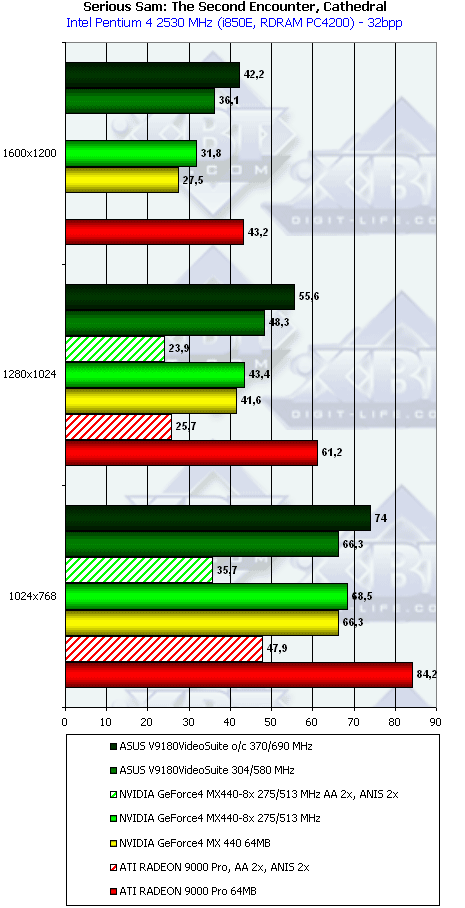 Quake3 Arena Comanche4 Benchmark Demo Unreal Tournament 2003 Demo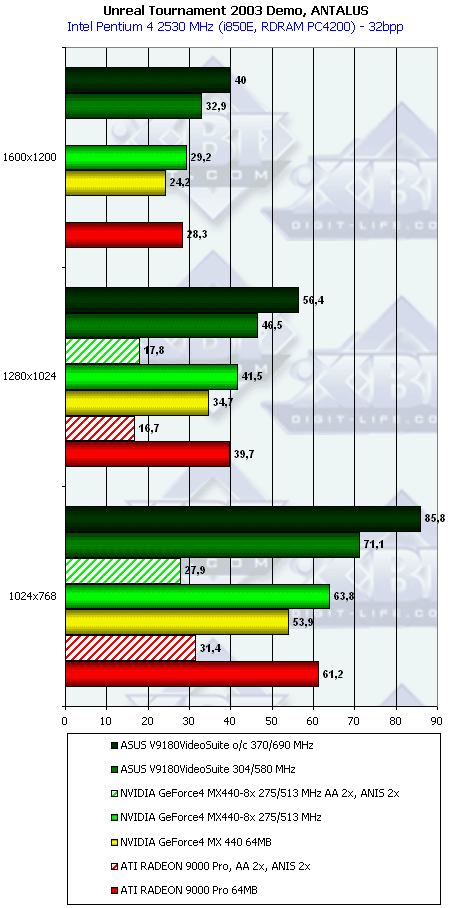 On the whole, the MX440-8x and RADEON 9000 Pro have similar scores, but remember that the latter has full DirectX 8.1 support, unlike to the MX, and multilevel anisotropy (waning as it might seem for the rivals of ATI). On the other hand, the MX440-8x has faster AA which is stronger than the ATI's SmoothVision able to run more or less fast only at 2x. I think the price will be the determining factor. If the new MX440-8x cars (except the ASUS) are over $100, they won't be a success, especially because of the Ti 4200 priced at $130-140. Many RADEON 9000 Pro have already surmounted $100 and keep on reducing their prices. Now about quality and reliability of the drivers. Last time I mentioned that quality of the ATI's software was inferior and that the MX440 would be more popular than the R9000 in spite of the shaders and other advantages of the latter. But the latest version of the ATI's drivers 6.200 shows no problems for the RADEON 9000, and the MX440 got some in the AA and anisotropy mode. In particular, the Comanche4 demonstrated white snow instead of grass - palms in snow looks exotic :). That bug in the Comanche4 was noticeable both with the enabled and disabled shaders. The MX440-8x also have some petite problems in the UT2003 with enabled AA and anisotropy. Summary performance diagrams of the video cards on the latest driver versions, October 2002The overclocked cards are marked with red color, the sign o/c (overclocked) is followed by the frequencies reached.
In closing I must say that all the cards were operating stably and flawlessly (certainly, within the test suite that we traditionally use we can't guarantee operation of all cards in all games because of the physical constraints :-). ConclusionAlthough the RADEON 9000 Pro keeps the MX440-8x cards from taking the top position in the mainstream sector, the ASUS V9180 VideoSuite proves to be a bright example of overbalance and victory. Although it will soon reach $100-105, you should think well whether it's worth chasing pixel shaders today or it's better to take a product similar to the RADEON 9000 Pro in performance and having VIVO and a rich software suite. The cards from ABIT and InnoVision are just good copies of the reference design. They are priced at $88-95 for the beginning of December. But with the price tags of $68-70 they can be excellent competitors against ATI. At the current prices the RADEON 9000 Pro remains the best choice ($89-90). In our 3Digest you can find complete comparison characteristics of video cards of this and other classes. Highs:
Lows:
.
Andrey Vorobiev (anvakams@ixbt.com)
Write a comment below. No registration needed!
|
Platform · Video · Multimedia · Mobile · Other || About us & Privacy policy · Twitter · Facebook Copyright © Byrds Research & Publishing, Ltd., 1997–2011. All rights reserved. |